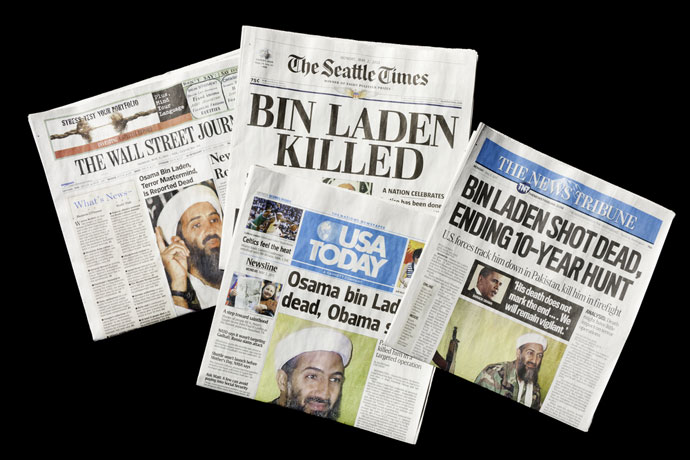Respected Journalist Seymour Hersh Thinks He’s Called Obama’s Bluff On Bin Laden Raid
On Sunday, investigative journalist Seymour Hersh wrote an article for the London Review of Books alleging that, “The White House’s story (about the U.S. Navy SEAL raid that took place in 2011 and resulted in the death of Osama bin Laden) might have been written by Lewis Carroll.” Were these the words of any other journalist, the claim may have gone unnoticed. But the words of someone whom CNN calls a “giant of investigative journalism,” who was the first to tell the story of the My Lai massacre in Vietnam in 1968, have credence to many in the world of reporting. Debate has followed suit on the credibility of his claims.
The highlights of Hersh’s claims largely go against what we have come to know about the raid. The story Americans heard have been fleshed out in the news, books like No Easy Day: The Firsthand Account of the Mission That Killed Osama Bin Laden by Mark Bissonette and interviews with Robert O’Neill, another former U.S. Navy SEAL. Since then, there has been some controversy over precisely who pulled the trigger that fateful night of the raid in Abbottabad, Pakistan. Aside from this, the story seems fairly consistent.
What We’ve Known To Be True
The account we’ve been told indicates that in the dead of night, U.S. Special Forces launched a clandestine operation, shooting five people including Bin Laden and leaving within about 40 minutes. There haven’t been many details released about the raid, but individuals who lived near the compound confirmed the presence of a helicopter and some kind of “huge window-shaking bang.”
Government officials, and deep-digging journalists, revealed that the operation came about after “weeks of detailed surveillance and planning involving the United States’ most sophisticated technology,” according to a report by the BBC. Part of this surveillance was the interception of a crucial phone call from the compound to a Bin Laden courier, whose identity had been gleaned from interrogations in Guantanamo.
BBC journalists conducted interviews with individuals who lived near the compound, indicating that occupants rarely moved in and out of the Bin Laden hiding place. The compound was stealthily observed via drone, and by individuals living in a CIA safe house nearby.
The night of May 2, 2011, the compound was stormed. The 23 US Navy SEALS participating in the operation lost their element of surprise when one of their helicopters took a hard and loud landing. A firefight ensued as they entered Osama’s hideaway. The only controversy through all of this was whether or not Osama used one of his wives as a human shield.
Reports tell us that Pakistan wasn’t notified of the raid until it was about to happen, and not once did they know that Bin Laden was the target. It wasn’t until 2 am, after the fires within the compound burned out, that Pakistan’s Chief of Army Staff was notified of all that had transpired. A phone call was made to Pakistani authorities at 5 am that morning from Admiral Michael Mullen, the US Chairman of the Joint Chiefs of Staff Committee. The only Pakistani we know of who was directly involved in the mission was a doctor named Shakeel Afridi, who helped the U.S. find out where Bin Laden was and what his compound looked like. He has since been imprisoned by Pakistan for his work against the state, and conspiring with the CIA.
Seymour Hersh’s Words
As Hersh tells it, this is not what happened. He refuses to identify his source, but says he knows that the U.S. government and the Pakistani government worked together all along to secure the capture or killing of Bin Laden. He alleges that the Pakistani military was essentially holding Bin Laden captive in the compound for years. The killing of Bin Laden was not a raid—it was a set up. Among many other aspects of the original story, this idea flies in the face of indications by those living near the compound that individuals inside were carefully, fearfully, and cautiously hiding.
According to Hersh, there was never a firefight. Pakistani intelligence (ISI) worked with the SEALs the day of the raid, in a support capacity. This allegation would make Bissonnette quite a creative writer, perhaps someone who should have considered a career in fiction writing rather than the military. It undermines the heroism and bravery exhibited by our nation’s service members that night.
As Hersh would have it, there was also no indication of a doctor helping the U.S.; only a “walk in” to the U.S. embassy. CNN’s Anderson Cooper points out in an interview with reporter Peter Bergen, who has spoken to numerous U.S. officials and visited the compound where Bin Laden lived, that “NBC does say that a Pakistani tipster did in fact walk up to the U.S. embassy in Islamabad to tip off American officials about Bin Laden’s whereabouts.” Bergen relents that this warrants further investigation, and there could be credibility to this idea. But he is quick to point out that this doesn’t mean Hersh’s story is true.
After all, nothing else seems to hold up. Hersh’s argument that a Pakistani army doctor verified the identity of Bin Laden flies in the face of the idea that the U.S. was not 100% certain Bin Laden was in the compound. The 2012 film Zero Dark Thirty, which is based on factual accounts of the raid, illustrates that intelligence was never sure that Bin Laden would be found in his alleged hiding place.
Why would government officials lie about their own uncertainty? There’s simply no reason to cover this up. When probed by Cooper about administration officials’ motivations for lying, Hersh evades the question, simply saying “political reasons.”
So what’s true, according to Hersh? Just that Bin Laden was killed.
Why Hersh’s Account Is Disturbing… In More Ways Than One
Hersh contradicts evidence given by residents of Abbottabad, journalists like Bergen who have seen the bullet-riddled compound, and U.S. government officials. But he also contradicts the words of individuals whom we can probably agree are American heroes. The Navy SEALs who risked their lives that day, as Hersh would have it, did nothing risky at all. Apparently, they simply walked into a secured environment and shot Bin Laden. Why this kind of operation would warrant Navy Seals, and why they would kill him without question if there was no firefight, is hard to determine.
Why do images of the compound that have been provided, as well as accounts by journalists, point to a firefight? Why would Saudi Arabia pay for Bin Laden to live in a compound in Abbottabad for years, which Bergen claims was part of a Saudi and Pakistani conspiracy? Bin Laden attempted to overthrow the Saudi royal family, and ultimately had his citizenship revoked, after all. The questions continue, and frankly, it seems irresponsible for Hersh to come out with this kind of story without any named sources that can 100% vouch for him.
If there’s any truth to Hersh’s story, this would of course be a tremendous scandal for the Obama administration. Fortunately, not many people seem to believe Hersh. Still, there’s still room for concern. Intelligence officials have told NBC News that “the Pakistani government knew where Bin Laden was hiding all along.” This kind of information needs to be further probed.
Nevertheless, contesting the story of the raid, calling it a fabrication, so far seems to be a stretch. More importantly, it does a disservice to every military member, government employee, and even the Pakistani doctor serving 30 years in prison for helping the US. Everyone who devoted time and was willing to sacrifice their lives for this raid deserves better than allegations without solid evidence.










































